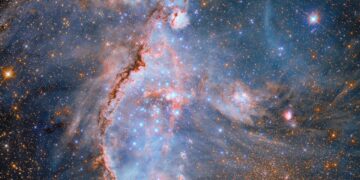To kick off the 35th anniversary of the Hubble Space Telescope, the European Space Agency (ESA) has gifted the world with a spectacular re-release of NGC 346—a young, vibrant star cluster nestled within the Small Magellanic Cloud. With the help of new data and advanced image-processing techniques, Hubble has once again transported us to one of the universe’s most dazzling star factories.
The Location: Small Magellanic Cloud and NGC 346
NGC 346 is located within the Small Magellanic Cloud (SMC), one of the Milky Way’s satellite galaxies. The SMC is metal-poor, meaning it contains fewer elements heavier than helium—conditions similar to those shortly after the Big Bang. This makes NGC 346 a cosmic time capsule, offering rare insight into early star formation under primitive galactic conditions.
The region’s surrounding nebula, N66, is the brightest H II region in the SMC, aglow from the intense ultraviolet radiation of its young stars. H II regions are active nurseries, indicating that star formation is ongoing and very recent—usually within the last few million years.
What Hubble Revealed: A Full-Spectrum Portrait
The newly processed image of NGC 346 is the first to combine Hubble’s infrared, optical, and ultraviolet observations into a single composite view. This multi-wavelength approach reveals the star cluster in unprecedented detail, capturing everything from the blazing blue light of massive stars to the dark tendrils of gas being sculpted by stellar winds.
According to ESA/Hubble, this data was collected over more than a decade, allowing scientists to trace star motion and observe structural changes within the cluster. The clarity and color richness of the image help astronomers distinguish different phases of star development—from embryonic stars still enshrouded in gas to massive, mature stars shaping the region around them.
The Discovery: Spiraling Gas Fuels Star Birth
One of the most compelling revelations from Hubble’s long-term observations is that the stars in NGC 346 are spiraling inward toward the cluster’s center. This motion isn’t random—it arises from a stream of gas flowing from the outer regions of the cluster, feeding the intense starburst happening in the core.
Researchers used two Hubble observation sets taken 11 years apart to measure stellar motion. They found that rather than moving chaotically, stars are migrating inward in a spiral pattern, like water circling a drain. This evidence suggests a sustained, inward collapse of gas—a fueling mechanism that powers the formation of massive stars at the cluster’s heart.
This is a breakthrough in our understanding of how massive star clusters grow and evolve, especially in environments that resemble the early universe.
NGC 346: A Young Cluster With Powerful Stars
The stars in NGC 346 are young, hot, and massive, some being dozens of times larger than our Sun. These stellar giants shine with a fierce blue hue and produce intense ultraviolet radiation. They also unleash strong stellar winds—streams of particles that carve bubble-like structures into the surrounding nebula.
These winds push away gas and dust, shaping the region while also triggering secondary star formation by compressing nearby clouds. The interaction between the stars and their environment transforms NGC 346 into a self-regulating factory, where young stars ignite the birth of future stars in a feedback loop of cosmic creation.
Why Metal-Poor Environments Like This Matter
NGC 346’s environment is similar to conditions found in distant, early galaxies. Since the SMC is relatively low in “metals” (everything heavier than helium), studying this cluster helps astronomers understand how stars formed in the first billion years of the universe—a time before galaxies were chemically enriched by supernovae and star evolution.
These low-metal conditions affect the temperature, mass, and lifespan of stars. By observing NGC 346, scientists can refine their models of early star formation and gain clues about the origins of the first galaxies.
This is especially relevant as newer telescopes like the James Webb Space Telescope (JWST) begin to observe the first galaxies directly. NGC 346 provides a local analog—a laboratory close enough to study in fine detail.
The Legacy of Hubble in Action
This latest release showcases not only the celestial beauty of NGC 346 but also the enduring legacy of the Hubble Space Telescope, which has revolutionized our view of the universe for 35 years. Hubble’s unmatched resolution and sensitivity have made it an icon of astronomy, capturing galaxies, nebulae, and star clusters with unparalleled clarity.
The reprocessing of this image using state-of-the-art techniques reflects how archival data can be reimagined with modern tools, extending the scientific value of each observation well beyond its initial release.
What We Learn from NGC 346
Studying NGC 346 is like opening a cosmic textbook on star birth and galactic evolution. Here’s what this star cluster teaches us:
- How massive stars form in metal-poor environments
- How gas flows trigger and regulate star formation
- How stellar feedback sculpts and transforms galactic environments
- How conditions in the early universe shaped galaxy development
This cluster isn’t just a light in the sky—it’s an evolutionary snapshot of our universe, frozen in time and space for us to decode.
Why This Image Matters to the Public
Beyond the science, NGC 346’s image is a visual gift to humanity, a celebration of exploration, knowledge, and curiosity. Its vibrant colors, complex structures, and almost painterly textures are artworks of nature, reminding us that space isn’t cold and empty—it’s dynamic, creative, and alive with activity.
It also shows how long-term missions like Hubble and the cooperation of international space agencies like ESA and NASA can yield lasting scientific and cultural value.
Conclusion: A Window Into the Cosmic Past
NGC 346 isn’t just a star cluster—it’s a living laboratory. Through Hubble’s lens, we’re witnessing the choreography of stellar birth, the flow of gas in deep space, and the echoes of a younger universe.

















